
|
| Home |
| Schedule |
| Tours |
| Plants |
| Speakers |
| Registration |
| Hotel |
| Directions |
| Contact |
Best Bloomin' Azaleas in Bay Country
ASA 2004 Convention
Tour C: Annapolis
Saturday, May 8, 2004
On Saturday, the Annapolis tour will include three private gardens—Carol Segree Gardens, Rosa Gardens, and Netherwood Garden—as well as the Wm. Paca Garden and historic Annapolis and its waterfront, where we’ll have our box lunch at City Dock. In the afternoon, we’ll visit the always-popular London Town gardens. Be forewarned: of all tours, this one will require the most walking.
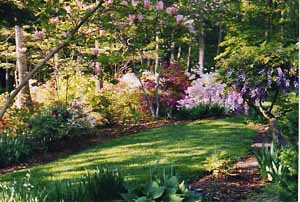 The day begins at the garden of Carol Segree in Gambrills (pictured right). This 1-acre garden is characterized by its network of paths that add interest and aid navigation on the wooded knoll that is bordered on three sides by steep ravines. Large trees—mostly oaks and tulip poplars—inhabit the property along with native hollies, dogwoods, and kalmia. Large- and small-leaf rhododendrons are blended with evergreen and deciduous azaleas.
The day begins at the garden of Carol Segree in Gambrills (pictured right). This 1-acre garden is characterized by its network of paths that add interest and aid navigation on the wooded knoll that is bordered on three sides by steep ravines. Large trees—mostly oaks and tulip poplars—inhabit the property along with native hollies, dogwoods, and kalmia. Large- and small-leaf rhododendrons are blended with evergreen and deciduous azaleas.
The property, which had been farmland and woods, was purchased in 1987. After joining the ARS in 1991 and the ASA in 1993, Carol’s small collection of white, pink, and red azaleas and ‘Roseum Elegans’ dramatically expanded to include more than 1,200 hybrid and species plants. She particularly likes the contrast of different textures and colors achieved by combining these plants, especially the deciduous azaleas with the evergreens.
| Views of Carol Segree's Garden: | ||

|

|
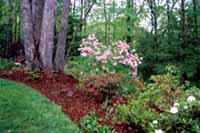
|

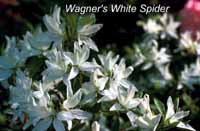 Carol has grown many from cuttings or seeds; however, most were acquired from auctions at the various ARS/ASA chapter functions. She is an active member of the Ben Morrison Chapter, ASA, and three ARS chapters. Her favorite azaleas are ‘Sweet Christy,’ ‘Wagner’s White Spider,’ ‘Fairfax,’ ‘Nancy of Robinhill,’ ‘Gay Paree,’ ‘Yamato,’ ‘Double Pleasure,’ ‘Ben Morrison,’ the natives, and many, many more!
Carol has grown many from cuttings or seeds; however, most were acquired from auctions at the various ARS/ASA chapter functions. She is an active member of the Ben Morrison Chapter, ASA, and three ARS chapters. Her favorite azaleas are ‘Sweet Christy,’ ‘Wagner’s White Spider,’ ‘Fairfax,’ ‘Nancy of Robinhill,’ ‘Gay Paree,’ ‘Yamato,’ ‘Double Pleasure,’ ‘Ben Morrison,’ the natives, and many, many more!
She is also partial to magnolias, Japanese maples, and peonies. Other plants of interest in this garden are Deodara Cedar (Cedrus deodara) and Dawn Redwood (Metasequoia glyptostroboides).
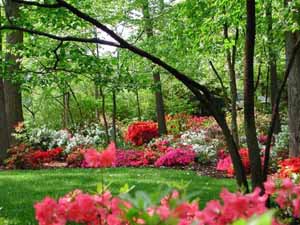 Rosa Gardens (pictured right), also in Gambrills, is the home of Rosa and Bob McWhorter. Bob, current president of the Ben Morrison chapter, likes to say his favorite hobby is digging holes; Rosa’s hobby is telling him where to dig them.
Rosa Gardens (pictured right), also in Gambrills, is the home of Rosa and Bob McWhorter. Bob, current president of the Ben Morrison chapter, likes to say his favorite hobby is digging holes; Rosa’s hobby is telling him where to dig them.
The vision of Rosa Gardens, begun in 1986, was slow to develop. The design of their home, lawn, and gardens is largely Rosa’s work, with new plantings working their way from the front to the back year by year. They first selected azaleas and rhododendrons available from local nurseries. After joining ASA in 1997 and ARS a year later, they increased the varieties of plants added. Now, Rosa Gardens consists of about 1,100 azaleas and several hundred rhododendrons, many with name tags. The gardens also include hundreds of daffodils, several varieties of hostas, and a small rose and perennial garden.
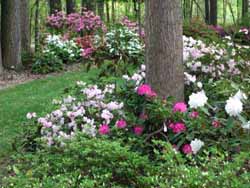 Bob likes a collage of colors, represented by the border of ‘Tradition’ azaleas in the front to the great views from many places along the trails, which Bob created. Once the trails were established, filling in with azaleas (and rhododendrons) wasn’t too difficult. The 2-acre property slopes to the rear and while most trails are an easy walk, there are a few steps. Favorite plants include ‘Rocket,’ ‘Lord Roberts,’ ‘The General,’ ‘Solidarity,’ and an unknown but beautiful fragrant lavender rhododendron from the garden of Russ Parsons, Mason-Dixon chapter of the ARS. He is also partial to ‘Blaauw’s Pink,’ ‘Sunglow,’ ‘Day Spring,’ ‘Purple Splendor’ and all the reds! Rosa’s favorites include ‘Carrie Amanda,’ ‘Pocono Pink,’ ‘Treasure’ and the deciduous azaleas.
Bob likes a collage of colors, represented by the border of ‘Tradition’ azaleas in the front to the great views from many places along the trails, which Bob created. Once the trails were established, filling in with azaleas (and rhododendrons) wasn’t too difficult. The 2-acre property slopes to the rear and while most trails are an easy walk, there are a few steps. Favorite plants include ‘Rocket,’ ‘Lord Roberts,’ ‘The General,’ ‘Solidarity,’ and an unknown but beautiful fragrant lavender rhododendron from the garden of Russ Parsons, Mason-Dixon chapter of the ARS. He is also partial to ‘Blaauw’s Pink,’ ‘Sunglow,’ ‘Day Spring,’ ‘Purple Splendor’ and all the reds! Rosa’s favorites include ‘Carrie Amanda,’ ‘Pocono Pink,’ ‘Treasure’ and the deciduous azaleas.
Bob installed the Raindrip watering system about 7 years ago and each of the 1,100 plants has its own dripper. Maintenance is simple, with surface hoses covered with mulch or leaves. The system has helped during the droughts the past few years.
The Ben Morrison chapter has been working with Barbara Bullock, Curator of the Azalea Collection at the US National Arboretum, on a conservation project, and an area of Rosa Gardens has been set aside for Arboretum azaleas.
Our next stop is Wm. Paca Garden in the center of historic Annapolis. Paca was a Revolutionary period governor of Maryland and a signer of the Declaration of Independence. His house, built between 1763 and 1765, is now a National Historic Landmark and is surrounded by a 2-acre garden carefully restored after the property was acquired by Historic Annapolis, Inc., which saved it from becoming a glass and steel office-and-apartment complex.
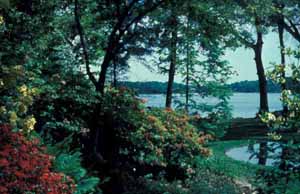 After a stroll through the garden, you’ll have time for a self-guided walking tour of Annapolis. Box lunches will be distributed for al fresco dining at City Dock prior to our visit to historic London Town and Gardens in Edgewater (right). From 1683 to the late 1700s, London Town, with its ready access to the Chesapeake Bay, was the place to cross the South River by ferry. London Town was also a port of call for ships taking tobacco to Britain and for bringing in slaves and servants. Today, the 23-acre site features the largest ongoing archaeological exploration in Maryland. The 8-acre garden includes woodlands, native and exotic species, the Richard Hill Medicinal Garden, the African American Garden, and the Anne Lambeth Kitchen garden. (Note: the tour does not include a visit to the William Brown House, a c.1760 Georgian brick home and tavern house; however, a $4.00 ticket may be purchased on site).
After a stroll through the garden, you’ll have time for a self-guided walking tour of Annapolis. Box lunches will be distributed for al fresco dining at City Dock prior to our visit to historic London Town and Gardens in Edgewater (right). From 1683 to the late 1700s, London Town, with its ready access to the Chesapeake Bay, was the place to cross the South River by ferry. London Town was also a port of call for ships taking tobacco to Britain and for bringing in slaves and servants. Today, the 23-acre site features the largest ongoing archaeological exploration in Maryland. The 8-acre garden includes woodlands, native and exotic species, the Richard Hill Medicinal Garden, the African American Garden, and the Anne Lambeth Kitchen garden. (Note: the tour does not include a visit to the William Brown House, a c.1760 Georgian brick home and tavern house; however, a $4.00 ticket may be purchased on site).
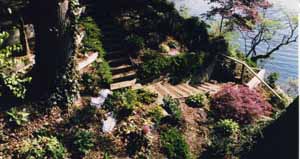 Our final stop for the afternoon will be the Netherwood Garden (pictured left)on the Severn River, the home of Paul and Joan Netherwood. With its small area (less than one-tenth of an acre) and steep terrain, landscaping proved to be a challenge. The owners, who inherited the Epping Forest property in June 1990, noted there were “no gardens to speak of”; gardening began in earnest in 1994.
Our final stop for the afternoon will be the Netherwood Garden (pictured left)on the Severn River, the home of Paul and Joan Netherwood. With its small area (less than one-tenth of an acre) and steep terrain, landscaping proved to be a challenge. The owners, who inherited the Epping Forest property in June 1990, noted there were “no gardens to speak of”; gardening began in earnest in 1994.
“We have really enjoyed working with the unusual size and shape of our property,” they said. “The steep hills on three sides were/are both a challenge and a delight. We had retaining walls built and a new set of steps built to make our walk down to the water easier. Using timbers, rocks, drift wood, small fountains, and small pieces of sculpture, we planned and planted our yard as a collection of many small self-contained gardens.
“Because of the small size of our yard, we have planted many dwarf rhododendrons, azaleas, laurels, hostas, boxwoods, and European gingers as one of several ground covers. Where space allowed, we have planted small and medium varieties of these same plants plus native plants and many ferns. To help control erosion, we have used small berm gardens to edge the waterfront yard, which is the only flat area on our property.
“Although the main emphasis of our garden is woody plants, we have some bloom most of the year. A collection of both regular and dwarf bulbs herald the coming of spring, with lilies blooming during the summer and many varieties of hosta blooming into mid-September. The Hellebores and Snowdrops give us color from December to March.”
NOTE: You must choose between Tour C and Tour D for Saturday, May 8, 2004.
The Alternative Saturday Tour:
|
|
|
|